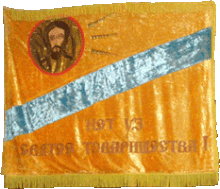Ussurian Cossack Army
The Ussurian Cossack Army was a Cossack army in the Imperial Russian Army from 1860 to 1918 . The habitat of the Ussuri Cossacks stretched along the Russian-Chinese river Ussuri , which formed a natural border with China . After their dissolution in 1918, they were reactivated in 1997 by a presidential decree .
history
Since 1655 , Cossacks had settled along the Ussuri, the 897 kilometer long right tributary of the Amur . As irregular troops , they took over border security on the Russian-Chinese border. The first military structured organization was in 1858, a Grenadier - Battalion , whose members came from the Trans-Baikal Cossack Army and from the Amur Cossack Army . The founding day of the Ussurian Cossack Army is June 1, 1860 . On June 26, 1889, the Ussirian Cossack Army was officially integrated into the Imperial Russian Army and thus became a regular force. Paul Simon Unterberger was appointed first commander in chief and ataman of the Ussuri Cossacks , the new headquarters and residence of the ataman was in Vladivostok . By 1902 the Cossack army grew to a division strength. In 1918, when the Cossack regiments returned to Grodekowo , they were disarmed by the Soviet authorities and their ataman, Grigory Mikhailovich Semyonov , was replaced. As an insurgent force, they joined the deposed ataman Semyonov and fought against the Bolsheviks . After the defeat of the White Army , the officers were deported to Siberia .
Outline and structure
After 1889 have been units of Cossack Army initially to 4 and later on 6 regiment districts ( Bikin , Glenowski , Grodekowo , Donskoi , Platono-Aleksandrovskoe , Poltawka ) dislocated . Each district consisted of 11 stanizas with about 300 inhabitants. In 1907 there were 71 stanizas with 2,852 households on their territory, and the number of residents was 20,753. Under the leadership of a captain , a hundred was established in each staniza . The smallest combat unit was the guards , they consisted of 15-20 men, later the small combat units were disbanded. The commanding ataman appointed a regimental captain for each district, the regimental captains formed a Cossack circle (a form of parliament). Almost 70 schools were established in the entire Ussuric Cossack area, which meant that children in almost every village (Cossack settlement) completed an education. The secondary schools , for example for officer training, were in Orenburg . The Ussuri Cossacks were involved in the following war missions: Boxer Rebellion 1900-1902, Russo-Japanese War 1904-1905, First World War 1914-1918 and during the Kornilov coup .
Uniform, colors and patron saint
The patron saint of the Ussuri Cossacks is Saint Alexius of Edessa , whose feast day the Orthodox churches celebrate on March 17th . The Ussuri Cossacks wore dark green uniforms with yellow stripes, yellow shoulder straps with a green border and a dark green cap with a yellow ribbon. The regimental flag from 1907 was a rectangular banner with the image of the Savior . There is a silvery willow ornament on the circumference of the green cloth. On the modern flag of the Urals regiment, the savior is replaced by a two-headed eagle and on the reverse a coat of arms with a tiger on the St. Andrew's cross is shown. There is also a description as a yellow banner with a blue diagonal stripe.
Cossacks of the Russian Federation
The Ussurian Cossack Army is one of the Cossack armies that were accepted into the Registered Cossacks of the Russian Federation by presidential decree in 1997 and are used for the protection of public order , border protection and police service.
Web links
- Ussuri Cossacks. On: cossackweb (english)
- Ussurian Cossack Army. On: fegi. Ru (Russian)



